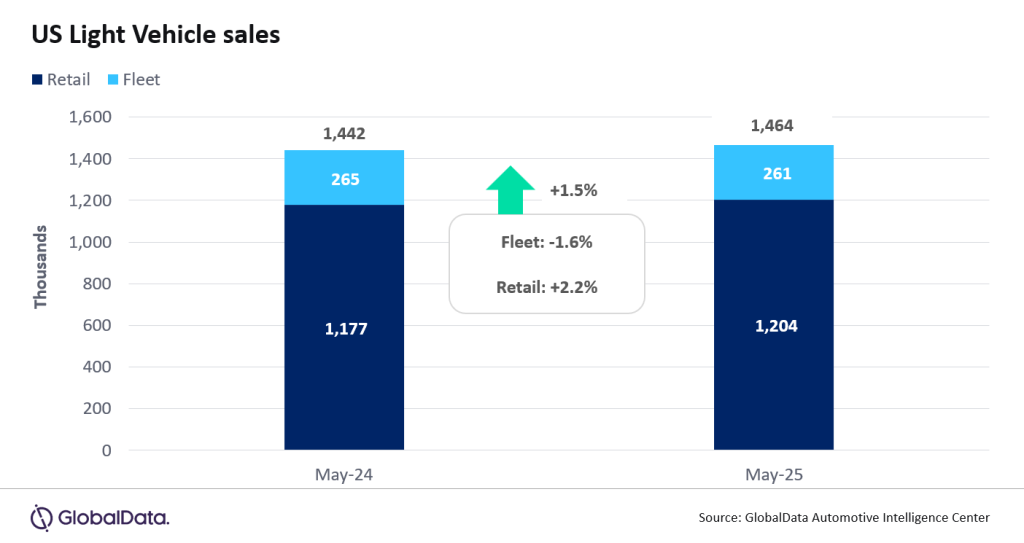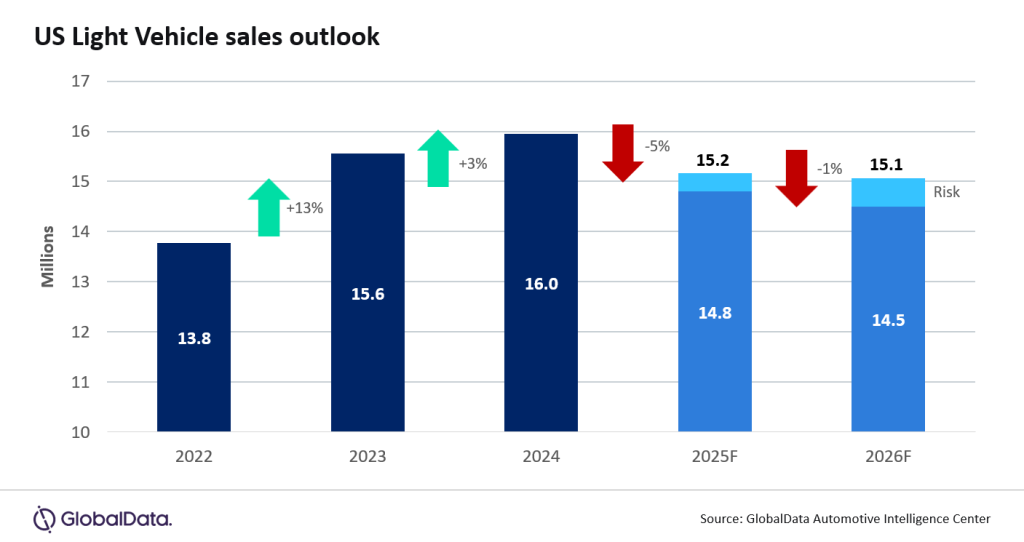Sales Summary
According to preliminary estimates, US Light Vehicle (LV) sales grew by 1.5% year-on-year (YoY) in May 2025, to 1.46 million units. May 2025 had one extra selling day compared to May 2024, meaning that sales fell by 2.2% YoY on a selling day-adjusted basis.

The daily selling rate was measured at 54.2k units/day in May, down from 56.7k units/day in April. The annualized selling rate was estimated at 15.3 million units/year in May, down from 17.4 million units/year in April. Retail sales were estimated at 1.2 million units, up by 2.2% YoY, while fleet sales were thought to total 261k units, down by 1.6% YoY.

OEM Analysis
GM once again led the market, with total sales of 258k units and a market share of 17.6%. However, a notably strong performance from Toyota Group meant that the gap between the Japanese OEM and GM was under 18k units in May, the smallest difference since April 2024. Toyota Group’s volumes (240k units) were its highest since May 2021. Even more remarkable was Ford Group, which enjoyed its highest monthly sales total since May 2019, with 215k units sold. At a brand level, Toyota led the rankings – as has been the case in each month of the year to date – on 207k units. However, Ford was close behind on 203k units, with Chevrolet in third on 163k units.
Model Analysis

US Tariffs are shifting - will you react or anticipate?
Don’t let policy changes catch you off guard. Stay proactive with real-time data and expert analysis.
By GlobalDataFor a second consecutive month, the Ford F-150 led the sales rankings, on 46.3k units. The Toyota RAV4 came in second, on 45.3k units, while the Chevrolet Silverado claimed third place in May, on 40.8k units. This was the first time since October 2024 that the Silverado had occupied such a lofty position. The Honda CR-V and Toyota Camry completed the top five. The Camry made its first appearance in the top five bestselling models since February 2023.
Segment Analysis
Compact Non-Premium SUV’s market share was 21% in May, according to initial estimates, its lowest share of the year to date. However, the segment’s market share was still up by 0.6 pp YoY. Midsize Non-Premium SUV accounted for 15.6% of the market in May, down around 0.2 pp from its April share, while Large Pickup enjoyed its highest share of 2025 so far, on 14.5%. Indeed, only one month since the beginning of 2023 (December 2024) has seen the segment claim a larger share of the total market. Enticing offers on models such as the Silverado seem to have driven an improved performance for Large Pickups.
David Oakley, Manager, Americas Sales Forecasts, GlobalData, said: “While sales in May were not poor by any means, the month’s results were a reflection of the way we have been expecting the market to develop since the picture regarding tariffs started to take shape. After the initial surge in sales activity in March and April, the decline in the selling rate in May appears to indicate that many of those consumers who decided to pull purchases ahead to avoid potential tariff-related pricing increases have now done so. We are also observing sharp differences in performance between OEMs. Certain automakers are starting to see problems with low inventory, which in some cases may be linked to hesitancy over how to respond to the imposition of tariffs. Similarly, brands that have tended to rely on fleet sales to boost volumes may be struggling in the current circumstances, as a higher priority is being put on more profitable retail sales – but retail sales depend to a great extent on the curb appeal of the models themselves. Finally, Premium makes are also seeing somewhat more subdued sales, although the reasons for this are varied. An over-reliance on EVs is a significant headwind for some brands, while others may be suffering from economic uncertainty and
tariff-related disruption”.

Forecast Updates
We currently expect 2025 sales to come in at around 15.2 million units, down from almost 16 million units in 2024, and representing a YoY decline of around 5%. While the extent to which sales will slow in June remains to be seen, we forecast the YoY comparison to turn negative, as prices increase and supply chain problems start to ramp up. The second half of the year is set to see a more significant slowdown in sales, as OEMs gradually adjust pricing to reflect the new realities of the trade environment. Still, the situation remains extremely fluid, and changes in the administration’s policy could mitigate the worst effects of tariffs, in which case there is some upside risk to our forecast.
This article was first published on GlobalData’s dedicated research platform, the Automotive Intelligence Center.




